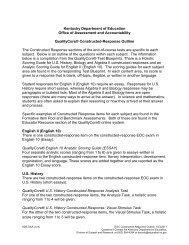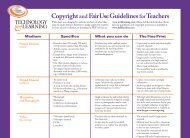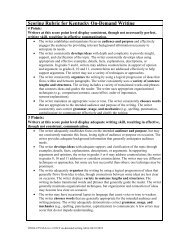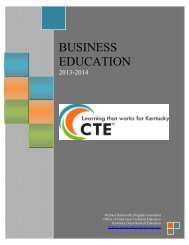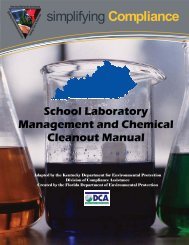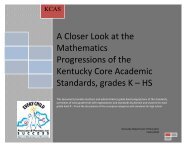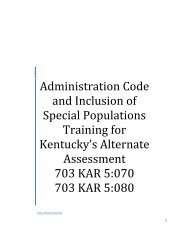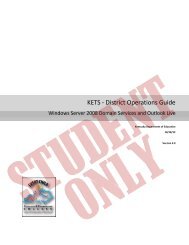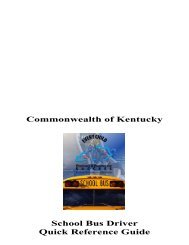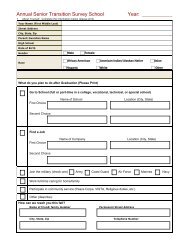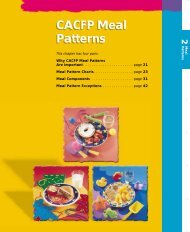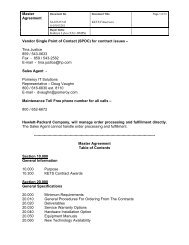Child and Human Development - Kentucky Department of Education
Child and Human Development - Kentucky Department of Education
Child and Human Development - Kentucky Department of Education
You also want an ePaper? Increase the reach of your titles
YUMPU automatically turns print PDFs into web optimized ePapers that Google loves.
<strong>Kentucky</strong> Career <strong>and</strong> Technical <strong>Education</strong>Curriculum Alignment Resource<strong>Child</strong> <strong>and</strong> <strong>Human</strong><strong>Development</strong>Project Launched October 2011
KENTUCKY CAREER PATHWAY/PROGRAM OF STUDY TEMPLATERecommended Course SequenceCOLLEGE/UNIVERSITY: Western <strong>Kentucky</strong> University CLUSTER: <strong>Human</strong> Services & <strong>Education</strong>HIGH SCHOOL (S):PATHWAY: Early <strong>Child</strong>hood EducatorPROGRAM: Family & Consumer Sciences- Early <strong>Child</strong>hood <strong>Education</strong>DRAFT GRADE ENGLISH MATH SCIENCE SOCIALRECOMMENDED ELECTIVE COURSESSTUDIESOTHER ELECTIVE COURSESCAREER AND TECHNICAL EDUCATION COURSESArts &Computer &9TechnologyEnglish I Algebra I ICP / Earth Science Social Science Health/PE <strong>Human</strong>ities Applications FACS Life SkillsWorld Relationships / Foods <strong>and</strong> <strong>Child</strong> & <strong>Human</strong>10English II Geometry Biology I World Civilization Language I Money Skills Nutrition<strong>Development</strong>World Parenting <strong>Child</strong> Dev. <strong>Child</strong> Dev.11English III Algebra II Chemistry US History Language IIServices I Services I12English IV Math Elective Science elective PsychologyBusinessManagementPrinciples <strong>of</strong>TeachingREQUIRED COURSES<strong>Child</strong> Dev.Services II<strong>Child</strong> Dev.Services IIWBL / Co-opCREDENTIALCERTIFICATEDIPLOMADEGREEKOSSA, AAFCS Pre-PAC (Early <strong>Child</strong>hood<strong>Education</strong>),Commonwealth <strong>Child</strong>Care Credential, CDA& WKU ArticulationYear 13English 100& SpeechYear 14English 200& <strong>Child</strong>ren'sLiteratureGeneralMath Cat D science PsychologyFamily <strong>and</strong>Community <strong>and</strong> Safety & FirstEarly <strong>Child</strong>hood Aid & FamilyPrograms RelationsWesternCivilizationWorking withYoung<strong>Child</strong>ren <strong>and</strong>FamiliesAssessment<strong>of</strong> Young<strong>Child</strong>ren<strong>Human</strong>NutritionGuidance &Peblem solvingApproaches forYoung <strong>Child</strong>renFoundations inFCS *Foundations inHunam ServicesCurr Dev for infants& toddlers & CurrDev for Preschool<strong>and</strong> KindergardenDiversity inEarly <strong>Child</strong>hoodProgramsAdminstration <strong>of</strong>Early <strong>Child</strong>hoodPrograms &Practicum3 HoursArticulation -Early <strong>Child</strong>hood<strong>Education</strong>AssociatesDegree- Early<strong>Child</strong>hood<strong>Education</strong>Year 15English 300ForeignLanguage<strong>Human</strong>itiesElective (2)Family Life<strong>Education</strong>PPTechniquesin FCSManagement <strong>of</strong>FamilyResourcesImplications <strong>of</strong>Research in<strong>Child</strong> <strong>and</strong> FamilyGrowth <strong>and</strong>Guidance <strong>of</strong><strong>Child</strong>renYear 16 WorldCritical Issues in Pr<strong>of</strong>essionalCultures -Family <strong>and</strong> <strong>Child</strong> Presentations inParentingExceptionalFolk Studies Statistics Studies FCSInternship Strategies Family Relations <strong>Education</strong>Required CoursesRecommended Elective CoursesOther Elective CoursesFunded by the U. S. <strong>Department</strong> <strong>of</strong> EducatioRequired Career <strong>and</strong> Technical <strong>Education</strong> Courses(V051B020001)Credit-Based Transition Programs (e.g. Dual/Concurrent Enrollment, Articulated Courses, 2+2+2)Revised Jan. 2005(◆=High School to Comm. College) (● =Com. College to 4-Yr Institution) (■ = Opportunity to test out)October, 2006-CTE/<strong>Kentucky</strong> M<strong>and</strong>atory Assessments, Advising, <strong>and</strong> Additional PreparationNote: Categories <strong>of</strong> courses (e.g. Required, Recommended Electives, other Electives <strong>and</strong> career <strong>and</strong> Technical <strong>Education</strong>) apply toboth secondary <strong>and</strong> postsecondary levels.Bachelor'sDegree in <strong>Child</strong>Studies (minorrequired)
CHILD/HUMAN DEVELOPMENTCourse Description:This course addresses the concepts related to underst<strong>and</strong>ing the areas <strong>and</strong> stages <strong>of</strong> human growth<strong>and</strong> development, recognizing effects <strong>of</strong> heredity <strong>and</strong> environment on human growth <strong>and</strong>development, meeting the needs <strong>of</strong> exceptional children, promoting optimum growth <strong>and</strong>development in the prenatal, infancy, toddler, preschool <strong>and</strong> school-age stages. Careers inchild/human development are explored. Leadership development will be provided through theFamily, Career <strong>and</strong> Community Leaders <strong>of</strong> America (FCCLA) student organization.Grade Level: 10-12 Credits: 0.5 – 1.0Students will:Technical Content / Process1. explain the areas <strong>of</strong> human growth <strong>and</strong> development.2. recognize the effects <strong>of</strong> heredity <strong>and</strong> environment on human growth <strong>and</strong> development.3. describe the stages <strong>of</strong> human growth <strong>and</strong> development across the lifespan.4. compare <strong>and</strong> contrast prenatal development during each trimester <strong>of</strong> pregnancy.5. categorize the types, characteristics <strong>and</strong> contributing factors <strong>of</strong> potential birth defects.6. characterize the signs, symptoms, <strong>and</strong> process <strong>of</strong> giving birth.7. identify factors that promote optimum growth <strong>and</strong> development in the infancy <strong>and</strong>toddler stages, including physical, social, emotional development <strong>and</strong> intellectualgrowth.8. identify factors that promote optimum growth <strong>and</strong> development in the preschool <strong>and</strong>school-age stages including physical, social, emotional <strong>and</strong> intellectual growth.9. recommend effective guidance techniques for dealing with inappropriate behavior.10. plan <strong>and</strong> organize developmentally appropriate activities for the preschool <strong>and</strong> schoolagechild.11. analyze conditions that influence human growth <strong>and</strong> development.12. describe methods <strong>of</strong> identifying exceptional children.13. identify health <strong>and</strong> safety issues for children.14. assess the effects <strong>of</strong> abuse <strong>and</strong> neglect on children <strong>and</strong> families.15. research <strong>and</strong> analyze information about careers in the field <strong>of</strong> child/hum<strong>and</strong>evelopment.16. utilize activities <strong>of</strong> the Family, Career <strong>and</strong> Community Leaders <strong>of</strong> America studentorganization as an integral component <strong>of</strong> course content <strong>and</strong> leadership development.17. apply math, science <strong>and</strong> communication skills within technical content.18. demonstrate employability <strong>and</strong> social skills relevant to the career cluster.ConnectionsNational St<strong>and</strong>ards for Family <strong>and</strong> Consumer SciencesPartnership for 21 st Century Skills<strong>Kentucky</strong> Core Academic St<strong>and</strong>ards – Former PL/VS Program <strong>of</strong> StudiesCommon Core St<strong>and</strong>ards for Mathematics <strong>and</strong> English/Language Arts<strong>Kentucky</strong> Occupational Skills St<strong>and</strong>ards Assessment (KOSSA) St<strong>and</strong>ards
<strong>Child</strong> <strong>and</strong> <strong>Human</strong> <strong>Development</strong>Course Title Grade Levels 10-12 Credit Value 0.5 - 1.0Description This course addresses the concepts related to underst<strong>and</strong>ing the areas <strong>and</strong> stages <strong>of</strong> human growth <strong>and</strong> development, recognizing effects <strong>of</strong> heredity <strong>and</strong> environment on human growth <strong>and</strong> development, meeting theneeds <strong>of</strong> exceptional children, promoting optimum growth <strong>and</strong> development in the infancy, toddler, preschool <strong>and</strong> school-age stages. Careers in child <strong>and</strong> human development are explored. Leadership developmentwill be provided through the Family, Career <strong>and</strong> Community Leaders <strong>of</strong> America (FCCLA) student organization.Prerequisites FACS Life Skills (preferred)Unit TitleIntroduction to <strong>Child</strong> <strong>Development</strong>Technical Content1. Students will explain the areas <strong>of</strong> human growth <strong>and</strong> development.2. Students will recognize the effects <strong>of</strong> heredity <strong>and</strong> environment on human growth <strong>and</strong> development.3. Students will describe the stages <strong>of</strong> human growth <strong>and</strong> development across the lifespan.National St<strong>and</strong>ards12.1.1 - Analyze physical, emotional, social, spiritual, <strong>and</strong> intellectual development.12.1.2 - Analyze interrelationships among physical, emotional, social, <strong>and</strong> intellectual aspects <strong>of</strong> human growth <strong>and</strong> development.12.2.1 - Analyze the effect <strong>of</strong> heredity <strong>and</strong> environment on human growth <strong>and</strong> development.12.2.2 - Analyze the impact <strong>of</strong> social, economic, <strong>and</strong> technological forces on individual growth <strong>and</strong> development.12.2.3 - Analyze the effects <strong>of</strong> gender, ethnicity, <strong>and</strong> culture on individual development.KY Core Academic St<strong>and</strong>ards (Big Idea)Biological Change (Biological Science) - ScienceThe only thing certain is that everything changes. At the high school level, students evaluate the role natural selection plays in the diversity <strong>of</strong> species. Modern ideas <strong>of</strong> evolution provide a scientific explanation for threemain sets <strong>of</strong> observable facts about life on Earth: the enormous number <strong>of</strong> different life forms we see about us, the systematic similarities in anatomy <strong>and</strong> molecular chemistry we see within that diversity, <strong>and</strong> thesequence <strong>of</strong> changes in fossils found in successive layers <strong>of</strong> rock that have been formed over more than a billion years.Personal Wellness (Health <strong>Education</strong>) - Practical LivingWellness is maximum well-being or total health. Personal wellness is a combination <strong>of</strong> physical, mental, emotional, spiritual <strong>and</strong> social well-being. It involves making behavioral choices <strong>and</strong> decisions each day thatpromote an individual’s physical well-being, the prevention <strong>of</strong> illnesses <strong>and</strong> diseases <strong>and</strong> the ability to remain, physically, mentally, spiritually, socially <strong>and</strong> emotionally healthy.Psychomotor Skills (Health <strong>Education</strong>) - Practical LivingCognitive information can be used to underst<strong>and</strong> <strong>and</strong> enhance the development <strong>of</strong> motor skills such as movement sequences <strong>and</strong> patterns. Individuals who underst<strong>and</strong> their bodies <strong>and</strong> how to perform variousmovements will be safer <strong>and</strong> more productive in recreation <strong>and</strong> work activities. <strong>Development</strong> <strong>of</strong> psychomotor skills contributes to the development <strong>of</strong> social <strong>and</strong> cognitive skills.English/Language Arts Common Core St<strong>and</strong>ardsCC.11-12.L.1 Conventions <strong>of</strong> St<strong>and</strong>ard English: Demonstrate comm<strong>and</strong> <strong>of</strong> the conventions <strong>of</strong> st<strong>and</strong>ard English grammar <strong>and</strong> usage when writing or speaking.CC.11-12.L.2 Conventions <strong>of</strong> St<strong>and</strong>ard English: Demonstrate comm<strong>and</strong> <strong>of</strong> the conventions <strong>of</strong> st<strong>and</strong>ard English capitalization, punctuation, <strong>and</strong> spelling when writing.CC.11-12.L.3 Knowledge <strong>of</strong> Language: Apply knowledge <strong>of</strong> language to underst<strong>and</strong> how language functions in different contexts, to make effective choices for meaning or style, <strong>and</strong> to comprehend more fully whenreading or listening.CC.11-12.W.2 Text Types <strong>and</strong> Purposes: Write informative/explanatory texts to examine <strong>and</strong> convey complex ideas, concepts, <strong>and</strong> information clearly <strong>and</strong> accurately through the effective selection, organization, <strong>and</strong>analysis <strong>of</strong> content.
Technical Literacy St<strong>and</strong>ardsReading / 9-10 / #4 – Determine the meaning <strong>of</strong> symbols, key terms, <strong>and</strong> other domain-specific words/phrases as they are used in specific scientific <strong>and</strong> technical context.Reading / 9-10 / #5 – Analyze the structure <strong>of</strong> the relationships among concepts in a text, including relationships among key terms.Reading / 9-10 / #7 – Translate quantitative or technical information expressed in words in a text into visual form (e.g. chart / table) <strong>and</strong> translate information expressed visually or mathematically (e.g. in an equation)into words.Writing / 9-10 / #4 – Produce clear <strong>and</strong> coherent writing in which the development, organization, <strong>and</strong> style are appropriate to task, purpose <strong>and</strong> audience.Writing / 9-10 / #7 – Conduct short as well as more sustained research projects to answer a question or solve a problem; narrow or broaden the inquiry when appropriate; synthesize multiple sources on the subject,demonstrating underst<strong>and</strong>ing <strong>of</strong> the subject under investigation.Writing / 9-10 / #8 – Gather relevant information from multiple authoritative print <strong>and</strong> digital sources, using advanced searches effectively; assess the strengths <strong>and</strong> limitations <strong>of</strong> each source in terms <strong>of</strong> specific task,purpose <strong>and</strong> audience; integrate information into the text selectively to maintain the flow <strong>of</strong> ideas, avoiding plagiarism <strong>and</strong> overreliance on any one source <strong>and</strong> following st<strong>and</strong>ard format for citation.Writing / 9-10 / #10 – Write routinely over extended time frames <strong>and</strong> shorter time frames for a range <strong>of</strong> discipline-specific tasks, purposes, <strong>and</strong> audiences.21st Century Skills <strong>and</strong> KnowledgeCritical Thinking <strong>and</strong> Problem SolvingEnvironmental LiteracyInitiative <strong>and</strong> Self-DirectionKOSSA St<strong>and</strong>ards3003.AA.1 Utilize effective verbal <strong>and</strong> non-verbal communication skills3003.AA.2 Participate in conversation, discussion, <strong>and</strong> group presentations3003.AA.3 Communicate <strong>and</strong> follow directions/procedures3003.AB.1 Locate <strong>and</strong> interpret written information3003.AB.3 Identify relevant details, facts, <strong>and</strong> specifications3003.AB.5 Demonstrate competence in organizing, writing, <strong>and</strong> editing using correct vocabulary, spelling, grammar, <strong>and</strong> punctuation3003.AB.6 Demonstrate the ability to write clearly <strong>and</strong> concisely using industry specific terminology3003.AC.1 Utilize critical-thinking skills to determine best options/outcomes (e.g., analyze reliable/unreliable sources <strong>of</strong> information, use previous experiences, implement crisis management, develop contingencyplanning)3003.AC.2 Utilize innovation <strong>and</strong> problem-solving skills to arrive at the best solution for current situation3003.AC.3 Implement effective decision-making skills3003.AD.4 Use tables, graphs, diagrams, <strong>and</strong> charts to obtain or convey information3003.AG.1 Use technology appropriately to enhance pr<strong>of</strong>essional presentations3003.EA.1 Demonstrate enthusiasm <strong>and</strong> confidence about work <strong>and</strong> learning new tasks3003.EA.2 Demonstrate consistent <strong>and</strong> punctual attendance3003.EA.3 Demonstrate initiative in assuming tasks3003.EA.6 Accept responsibility for personal decisions <strong>and</strong> actions3003.EB.2 Demonstrate honesty <strong>and</strong> reliability3003.EB.3 Demonstrate ethical characteristics <strong>and</strong> behaviors3003.EC.2 Use language <strong>and</strong> manners suitable for the workplace3003.EC.3 Demonstrate polite <strong>and</strong> respectful behavior toward others3003.EC.5 Demonstrate pride in work3003.ED.1 Plan <strong>and</strong> follow a work schedule3003.ED.4 Demonstrate ability to stay on task to produce high quality deliverables on time3003.EE.4 Explain the importance <strong>of</strong> respect for feelings, values, <strong>and</strong> beliefs <strong>of</strong> others
3003.EE.5 Identify strategies to bridge cultural/generational differences <strong>and</strong> use differing perspectives to increase overall quality <strong>of</strong> work3003.EF.1 Recognize the characteristics <strong>of</strong> a team environment <strong>and</strong> conventional workplace3003.EF.2 Contribute to the success <strong>of</strong> the team3003.EF.3 Demonstrate effective team skills <strong>and</strong> evaluate their importance in the workplace (e.g., setting goals, listening, following directions, questioning, dividing work)3003.EG.1 Contribute new ideas3003.EG.2 Stimulate ideas by posing questions3003.EG.3 Value varying ideas <strong>and</strong> opinions3003.EG.4 Locate <strong>and</strong> verify information3003.OC.1 Examine child development theories <strong>and</strong> their implications for educational <strong>and</strong> childcare practices3003.OC.3 Consider cultural <strong>and</strong> environmental influences with assessing children’s developmentLearning TargetsIdentify reasons to learn about child development.Compare <strong>and</strong> contrast physical, social, emotional <strong>and</strong> intellectual development.Recognize <strong>and</strong> assess the effects <strong>of</strong> heredity <strong>and</strong> environment on growth <strong>and</strong> development.Analyze conditions that influence growth <strong>and</strong> development.Differentiate between the different ages <strong>and</strong> stages <strong>of</strong> child development.Describe theorists who have influenced child <strong>and</strong> human development.
<strong>Child</strong> <strong>and</strong> <strong>Human</strong> <strong>Development</strong>Course Title Grade Levels 10-12 Credit Value 0.5 - 1.0Description This course addresses the concepts related to underst<strong>and</strong>ing the areas <strong>and</strong> stages <strong>of</strong> human growth <strong>and</strong> development, recognizing effects <strong>of</strong> heredity <strong>and</strong> environment on human growth <strong>and</strong> development, meeting theneeds <strong>of</strong> exceptional children, promoting optimum growth <strong>and</strong> development in the infancy, toddler, preschool <strong>and</strong> school-age stages. Careers in child <strong>and</strong> human development are explored. Leadership developmentwill be provided through the Family, Career <strong>and</strong> Community Leaders <strong>of</strong> America (FCCLA) student organization.Prerequisites FACS Life Skills (preferred)Unit TitlePregnancy & BirthTechnical Content4. Students will compare <strong>and</strong> contrast prenatal development during each trimester <strong>of</strong> pregnancy.5. Students will categorize the types, characteristics <strong>and</strong> contributing factors <strong>of</strong> potential birth defects.6. Students will characterize the signs, symptoms, <strong>and</strong> process <strong>of</strong> giving birth.11. Students will analyze conditions that influence human growth <strong>and</strong> development.National St<strong>and</strong>ards12.1.2 - Analyze interrelationships among physical, emotional, social, <strong>and</strong> intellectual aspects <strong>of</strong> human growth <strong>and</strong> development.12.1.3 - Analyze current <strong>and</strong> emerging research about human growth <strong>and</strong> development, including research on brain development.15.2.1 - Choose nurturing practices that support human growth <strong>and</strong> development.15.2.2 - Apply communication strategies that promote positive self-esteem in family members.15.4.1 - Analyze biological processes related to prenatal development, birth, <strong>and</strong> health <strong>of</strong> child <strong>and</strong> mother.15.4.2 - Analyze the emotional factors <strong>of</strong> prenatal development <strong>and</strong> birth in relation to the health <strong>of</strong> parents <strong>and</strong> child.KY Core Academic St<strong>and</strong>ards (Big Idea)Biological Change (Biological Science) - ScienceThe only thing certain is that everything changes. At the high school level, students evaluate the role natural selection plays in the diversity <strong>of</strong> species. Modern ideas <strong>of</strong> evolution provide a scientific explanation for threemain sets <strong>of</strong> observable facts about life on Earth: the enormous number <strong>of</strong> different life forms we see about us, the systematic similarities in anatomy <strong>and</strong> molecular chemistry we see within that diversity, <strong>and</strong> thesequence <strong>of</strong> changes in fossils found in successive layers <strong>of</strong> rock that have been formed over more than a billion years.Nutrition (Health <strong>Education</strong>) - Practical LivingProper nutrition is critical to good health. To maintain a healthy weight, good dietary habits <strong>and</strong> physical activity are essential. Nutritious foods are necessary for growth, development <strong>and</strong> maintenance <strong>of</strong> healthybodies.Lifetime Physical Wellness (Physical <strong>Education</strong>) - Practical LivingLifetime wellness is health-focused. The health-related activities <strong>and</strong> content utilized are presented to help students become more responsible for their overall health status <strong>and</strong> to prepare each student to demonstrateknowledge <strong>and</strong> skills that promote physical activity throughout their lives. Physical education uses physical activity as a means to help students acquire skills, fitness, knowledge <strong>and</strong> attitudes that contribute to theiroptimal development <strong>and</strong> well-being. Physical, mental, emotional <strong>and</strong> social health is strengthened by regular involvement in physical activities.Personal Wellness (Health <strong>Education</strong>) - Practical LivingWellness is maximum well-being or total health. Personal wellness is a combination <strong>of</strong> physical, mental, emotional, spiritual <strong>and</strong> social well-being. It involves making behavioral choices <strong>and</strong> decisions each day thatpromote an individual’s physical well-being, the prevention <strong>of</strong> illnesses <strong>and</strong> diseases <strong>and</strong> the ability to remain, physically, mentally, spiritually, socially <strong>and</strong> emotionally healthy.English/Language Arts Common Core St<strong>and</strong>ardsCC.11-12.L.1 Conventions <strong>of</strong> St<strong>and</strong>ard English: Demonstrate comm<strong>and</strong> <strong>of</strong> the conventions <strong>of</strong> st<strong>and</strong>ard English grammar <strong>and</strong> usage when writing or speaking.CC.11-12.L.2 Conventions <strong>of</strong> St<strong>and</strong>ard English: Demonstrate comm<strong>and</strong> <strong>of</strong> the conventions <strong>of</strong> st<strong>and</strong>ard English capitalization, punctuation, <strong>and</strong> spelling when writing.CC.11-12.L.3 Knowledge <strong>of</strong> Language: Apply knowledge <strong>of</strong> language to underst<strong>and</strong> how language functions in different contexts, to make effective choices for meaning or style, <strong>and</strong> to comprehend more fully whenreading or listening.CC.11-12.SL.1 Comprehension <strong>and</strong> Collaboration: Initiate <strong>and</strong> participate effectively in a range <strong>of</strong> collaborative discussions (one-on-one, in groups, <strong>and</strong> teacher-led) with diverse partners on grades 11–12 topics, texts,<strong>and</strong> issues, building on others’ ideas <strong>and</strong> expressing their own clearly <strong>and</strong> persuasively.
Technical Literacy St<strong>and</strong>ardsReading / 9-10 / #1 – Cite specific textual evidence to support analysis <strong>of</strong> science <strong>and</strong> technical texts, attending to the precise details <strong>of</strong> explanations or descriptions.Reading / 9-10 / #2 – Determine the central ideas or conclusions <strong>of</strong> a text; trace the text’s explanation or depiction <strong>of</strong> a complex process, phenomenon, or concept; provide an accurate summary <strong>of</strong> the text.Reading / 9-10 / #4 – Determine the meaning <strong>of</strong> symbols, key terms, <strong>and</strong> other domain-specific words/phrases as they are used in specific scientific <strong>and</strong> technical context.Reading / 9-10 / #5 – Analyze the structure <strong>of</strong> the relationships among concepts in a text, including relationships among key terms.Writing / 9-10 / #1 – Write arguments focused on discipline-specific content.Writing / 9-10 / #2 – Write informative / explanatory texts, including narration <strong>of</strong> historical events, scientific procedures / experiments, or technical processes.Writing / 9-10 / #4 – Produce clear <strong>and</strong> coherent writing in which the development, organization, <strong>and</strong> style are appropriate to task, purpose <strong>and</strong> audience.Writing / 9-10 / #7 – Conduct short as well as more sustained research projects to answer a question or solve a problem; narrow or broaden the inquiry when appropriate; synthesize multiple sources on the subject,demonstrating underst<strong>and</strong>ing <strong>of</strong> the subject under investigation.Writing / 9-10 / #10 – Write routinely over extended time frames <strong>and</strong> shorter time frames for a range <strong>of</strong> discipline-specific tasks, purposes, <strong>and</strong> audiences.Mathematics Common Core St<strong>and</strong>ardsCC.9-12.S.IC.6 Evaluate reports based on data.*21st Century Skills <strong>and</strong> KnowledgeCritical Thinking <strong>and</strong> Problem SolvingEnvironmental LiteracyHealth LiteracyKOSSA St<strong>and</strong>ards3003.OK.1 Examine parenting roles across the life span3003.OK.2 Examine expectations <strong>and</strong> responsibilities <strong>of</strong> parenting3003.OK.3 Determine consequences <strong>of</strong> parenting practices to the individual, family, <strong>and</strong> society3003.OK.4 Determine societal conditions that impact parenting across the life span3003.OK.5 Explain cultural differences in roles <strong>and</strong> responsibilities <strong>of</strong> parenting3003.ON.1 Examine biological processes related to prenatal development, birth, <strong>and</strong> health <strong>of</strong> child <strong>and</strong> mother3003.ON.2 Consider the emotional factors <strong>of</strong> prenatal development <strong>and</strong> birth in relation to the health <strong>of</strong> the parents <strong>and</strong> child3003.ON.3 Examine implications <strong>of</strong> alternatives to biological parenthoodLearning TargetsIdentify the early signs <strong>of</strong> pregnancy.Examine how adequate prenatal care affects the development <strong>of</strong> the mother <strong>and</strong> unborn child.Compare <strong>and</strong> contrast fetal development during each trimester <strong>of</strong> pregnancy.Analyze factors that contribute to reducing birth defects.Evaluate the preparations expectant parents should make.Identify signs <strong>and</strong> symptoms <strong>of</strong> labor.Explain the birth process.
<strong>Child</strong> <strong>and</strong> <strong>Human</strong> <strong>Development</strong>Course Title Grade Levels 10-12 Credit Value 0.5 - 1.0Description This course addresses the concepts related to underst<strong>and</strong>ing the areas <strong>and</strong> stages <strong>of</strong> human growth <strong>and</strong> development, recognizing effects <strong>of</strong> heredity <strong>and</strong> environment on human growth <strong>and</strong> development, meeting theneeds <strong>of</strong> exceptional children, promoting optimum growth <strong>and</strong> development in the infancy, toddler, preschool <strong>and</strong> school-age stages. Careers in child <strong>and</strong> human development are explored. Leadership developmentwill be provided through the Family, Career <strong>and</strong> Community Leaders <strong>of</strong> America (FCCLA) student organization.Prerequisites FACS Life Skills (preferred)Unit TitleInfancyTechnical Content7. Students will identify factors that promote optimum growth <strong>and</strong> development in the infancy <strong>and</strong> toddler stages, including physical, social, emotional development <strong>and</strong> intellectual growth.11. Students will analyze conditions that influence human growth <strong>and</strong> development.National St<strong>and</strong>ards12.1.1 - Analyze physical, emotional, social, spiritual, <strong>and</strong> intellectual development.12.1.3 - Analyze current <strong>and</strong> emerging research about human growth <strong>and</strong> development, including research on brain development.12.2.1 - Analyze the effect <strong>of</strong> heredity <strong>and</strong> environment on human growth <strong>and</strong> development.12.2.4 - Analyze the effects <strong>of</strong> life events on individuals' physical, intellectual, social, moral, <strong>and</strong> emotional development.12.2.5 - Analyze geographic, political, <strong>and</strong> global influences on human growth <strong>and</strong> development.12.3.1 - Analyze the role <strong>of</strong> nurturance on human growth <strong>and</strong> development.12.3.2 - Analyze the role <strong>of</strong> communication on human growth <strong>and</strong> development.KY Core Academic St<strong>and</strong>ards (Big Idea)Nutrition (Health <strong>Education</strong>) - Practical LivingProper nutrition is critical to good health. To maintain a healthy weight, good dietary habits <strong>and</strong> physical activity are essential. Nutritious foods are necessary for growth, development <strong>and</strong> maintenance <strong>of</strong> healthybodies.Personal Wellness (Health <strong>Education</strong>) - Practical LivingWellness is maximum well-being or total health. Personal wellness is a combination <strong>of</strong> physical, mental, emotional, spiritual <strong>and</strong> social well-being. It involves making behavioral choices <strong>and</strong> decisions each day thatpromote an individual’s physical well-being, the prevention <strong>of</strong> illnesses <strong>and</strong> diseases <strong>and</strong> the ability to remain, physically, mentally, spiritually, socially <strong>and</strong> emotionally healthy.Psychomotor Skills (Health <strong>Education</strong>) - Practical LivingCognitive information can be used to underst<strong>and</strong> <strong>and</strong> enhance the development <strong>of</strong> motor skills such as movement sequences <strong>and</strong> patterns. Individuals who underst<strong>and</strong> their bodies <strong>and</strong> how to perform variousmovements will be safer <strong>and</strong> more productive in recreation <strong>and</strong> work activities. <strong>Development</strong> <strong>of</strong> psychomotor skills contributes to the development <strong>of</strong> social <strong>and</strong> cognitive skills.English/Language Arts Common Core St<strong>and</strong>ardsCC.11-12.L.1 Conventions <strong>of</strong> St<strong>and</strong>ard English: Demonstrate comm<strong>and</strong> <strong>of</strong> the conventions <strong>of</strong> st<strong>and</strong>ard English grammar <strong>and</strong> usage when writing or speaking.CC.11-12.L.2 Conventions <strong>of</strong> St<strong>and</strong>ard English: Demonstrate comm<strong>and</strong> <strong>of</strong> the conventions <strong>of</strong> st<strong>and</strong>ard English capitalization, punctuation, <strong>and</strong> spelling when writing.CC.11-12.L.3 Knowledge <strong>of</strong> Language: Apply knowledge <strong>of</strong> language to underst<strong>and</strong> how language functions in different contexts, to make effective choices for meaning or style, <strong>and</strong> to comprehend more fully whenreading or listening.CC.11-12.W.1 Text Types <strong>and</strong> Purposes: Write arguments to support claims in an analysis <strong>of</strong> substantive topics or texts, using valid reasoning <strong>and</strong> relevant <strong>and</strong> sufficient evidence.CC.11-12.SL.1 Comprehension <strong>and</strong> Collaboration: Initiate <strong>and</strong> participate effectively in a range <strong>of</strong> collaborative discussions (one-on-one, in groups, <strong>and</strong> teacher-led) with diverse partners on grades 11–12 topics, texts,<strong>and</strong> issues, building on others’ ideas <strong>and</strong> expressing their own clearly <strong>and</strong> persuasively.
Technical Literacy St<strong>and</strong>ardsReading / 9-10 / #4 – Determine the meaning <strong>of</strong> symbols, key terms, <strong>and</strong> other domain-specific words/phrases as they are used in specific scientific <strong>and</strong> technical context.Reading / 9-10 / #7 – Translate quantitative or technical information expressed in words in a text into visual form (e.g. chart / table) <strong>and</strong> translate information expressed visually or mathematically (e.g. in an equation)into words.Writing / 9-10 / #1 – Write arguments focused on discipline-specific content.Writing / 9-10 / #4 – Produce clear <strong>and</strong> coherent writing in which the development, organization, <strong>and</strong> style are appropriate to task, purpose <strong>and</strong> audience.Writing / 9-10 / #7 – Conduct short as well as more sustained research projects to answer a question or solve a problem; narrow or broaden the inquiry when appropriate; synthesize multiple sources on the subject,demonstrating underst<strong>and</strong>ing <strong>of</strong> the subject under investigation.Writing / 9-10 / #9 – Draw evidence from informational texts to support analysis, reflection, <strong>and</strong> research.Writing / 9-10 / #10 – Write routinely over extended time frames <strong>and</strong> shorter time frames for a range <strong>of</strong> discipline-specific tasks, purposes, <strong>and</strong> audiences.Mathematics Common Core St<strong>and</strong>ardsCC.9-12.S.IC.6 Evaluate reports based on data.*21st Century Skills <strong>and</strong> KnowledgeCommunicationCritical Thinking <strong>and</strong> Problem SolvingHealth LiteracyFlexibility <strong>and</strong> AdaptabilityKOSSA St<strong>and</strong>ards3003.EA.1 Demonstrate enthusiasm <strong>and</strong> confidence about work <strong>and</strong> learning new tasks3003.EA.2 Demonstrate consistent <strong>and</strong> punctual attendance3003.EA.3 Demonstrate initiative in assuming tasks3003.EA.6 Accept responsibility for personal decisions <strong>and</strong> actions3003.EB.2 Demonstrate honesty <strong>and</strong> reliability3003.EB.3 Demonstrate ethical characteristics <strong>and</strong> behaviors3003.EC.2 Use language <strong>and</strong> manners suitable for the workplace3003.EC.3 Demonstrate polite <strong>and</strong> respectful behavior toward others3003.EC.5 Demonstrate pride in work3003.ED.1 Plan <strong>and</strong> follow a work schedule3003.ED.4 Demonstrate ability to stay on task to produce high quality deliverables on time3003.EF.1 Recognize the characteristics <strong>of</strong> a team environment <strong>and</strong> conventional workplace3003.EF.2 Contribute to the success <strong>of</strong> the team3003.EF.3 Demonstrate effective team skills <strong>and</strong> evaluate their importance in the workplace (e.g., setting goals, listening, following directions, questioning, dividing work)Learning TargetsExamine <strong>and</strong> analyze how infants develop physically.Explain how physical development affects infant care.Examine <strong>and</strong> analyze how infants develop socially.Examine <strong>and</strong> analyze how infants develop emotionally.Identify the parts <strong>and</strong> functions <strong>of</strong> the brain <strong>and</strong> how it affects intellectual development.Examine <strong>and</strong> analyze how infants develop intellectually.
<strong>Child</strong> <strong>and</strong> <strong>Human</strong> <strong>Development</strong>Course Title Grade Levels 10-12 Credit Value 0.5 - 1.0Description This course addresses the concepts related to underst<strong>and</strong>ing the areas <strong>and</strong> stages <strong>of</strong> human growth <strong>and</strong> development, recognizing effects <strong>of</strong> heredity <strong>and</strong> environment on human growth <strong>and</strong> development, meeting theneeds <strong>of</strong> exceptional children, promoting optimum growth <strong>and</strong> development in the infancy, toddler, preschool <strong>and</strong> school-age stages. Careers in child <strong>and</strong> human development are explored. Leadership developmentwill be provided through the Family, Career <strong>and</strong> Community Leaders <strong>of</strong> America (FCCLA) student organization.Prerequisites FACS Life Skills (preferred)Unit TitleToddlersTechnical Content7. Students will identify factors that promote optimum growth <strong>and</strong> development in the infancy <strong>and</strong> toddler stages, including physical, social, emotional development <strong>and</strong> intellectual growth.11. Students will analyze conditions that influence human growth <strong>and</strong> development.National St<strong>and</strong>ards12.1.2 - Analyze interrelationships among physical, emotional, social, <strong>and</strong> intellectual aspects <strong>of</strong> human growth <strong>and</strong> development.12.1.3 - Analyze current <strong>and</strong> emerging research about human growth <strong>and</strong> development, including research on brain development.12.2.1 - Analyze the effect <strong>of</strong> heredity <strong>and</strong> environment on human growth <strong>and</strong> development.12.2.4 - Analyze the effects <strong>of</strong> life events on individuals' physical, intellectual, social, moral, <strong>and</strong> emotional development.12.2.5 - Analyze geographic, political, <strong>and</strong> global influences on human growth <strong>and</strong> development.12.3.1 - Analyze the role <strong>of</strong> nurturance on human growth <strong>and</strong> development.12.3.2 - Analyze the role <strong>of</strong> communication on human growth <strong>and</strong> development.15.2.1 - Choose nurturing practices that support human growth <strong>and</strong> development.15.2.2 - Apply communication strategies that promote positive self-esteem in family members.15.2.3 - Assess common practices <strong>and</strong> emerging research about discipline on human growth <strong>and</strong> development.KY Core Academic St<strong>and</strong>ards (Big Idea)Biological Change (Biological Science) - ScienceThe only thing certain is that everything changes. At the high school level, students evaluate the role natural selection plays in the diversity <strong>of</strong> species. Modern ideas <strong>of</strong> evolution provide a scientific explanation for threemain sets <strong>of</strong> observable facts about life on Earth: the enormous number <strong>of</strong> different life forms we see about us, the systematic similarities in anatomy <strong>and</strong> molecular chemistry we see within that diversity, <strong>and</strong> thesequence <strong>of</strong> changes in fossils found in successive layers <strong>of</strong> rock that have been formed over more than a billion years.Lifetime Physical Wellness (Physical <strong>Education</strong>) - Practical LivingLifetime wellness is health-focused. The health-related activities <strong>and</strong> content utilized are presented to help students become more responsible for their overall health status <strong>and</strong> to prepare each student to demonstrateknowledge <strong>and</strong> skills that promote physical activity throughout their lives. Physical education uses physical activity as a means to help students acquire skills, fitness, knowledge <strong>and</strong> attitudes that contribute to theiroptimal development <strong>and</strong> well-being. Physical, mental, emotional <strong>and</strong> social health is strengthened by regular involvement in physical activities.Nutrition (Health <strong>Education</strong>) - Practical LivingProper nutrition is critical to good health. To maintain a healthy weight, good dietary habits <strong>and</strong> physical activity are essential. Nutritious foods are necessary for growth, development <strong>and</strong> maintenance <strong>of</strong> healthybodies.Personal Wellness (Health <strong>Education</strong>) - Practical LivingWellness is maximum well-being or total health. Personal wellness is a combination <strong>of</strong> physical, mental, emotional, spiritual <strong>and</strong> social well-being. It involves making behavioral choices <strong>and</strong> decisions each day thatpromote an individual’s physical well-being, the prevention <strong>of</strong> illnesses <strong>and</strong> diseases <strong>and</strong> the ability to remain, physically, mentally, spiritually, socially <strong>and</strong> emotionally healthy.Psychomotor Skills (Health <strong>Education</strong>) - Practical LivingCognitive information can be used to underst<strong>and</strong> <strong>and</strong> enhance the development <strong>of</strong> motor skills such as movement sequences <strong>and</strong> patterns. Individuals who underst<strong>and</strong> their bodies <strong>and</strong> how to perform variousmovements will be safer <strong>and</strong> more productive in recreation <strong>and</strong> work activities. <strong>Development</strong> <strong>of</strong> psychomotor skills contributes to the development <strong>of</strong> social <strong>and</strong> cognitive skills.
English/Language Arts Common Core St<strong>and</strong>ardsCC.11-12.L.1 Conventions <strong>of</strong> St<strong>and</strong>ard English: Demonstrate comm<strong>and</strong> <strong>of</strong> the conventions <strong>of</strong> st<strong>and</strong>ard English grammar <strong>and</strong> usage when writing or speaking.CC.11-12.L.2 Conventions <strong>of</strong> St<strong>and</strong>ard English: Demonstrate comm<strong>and</strong> <strong>of</strong> the conventions <strong>of</strong> st<strong>and</strong>ard English capitalization, punctuation, <strong>and</strong> spelling when writing.CC.11-12.L.3 Knowledge <strong>of</strong> Language: Apply knowledge <strong>of</strong> language to underst<strong>and</strong> how language functions in different contexts, to make effective choices for meaning or style, <strong>and</strong> to comprehend more fully whenreading or listening.CC.11-12.SL.1 Comprehension <strong>and</strong> Collaboration: Initiate <strong>and</strong> participate effectively in a range <strong>of</strong> collaborative discussions (one-on-one, in groups, <strong>and</strong> teacher-led) with diverse partners on grades 11–12 topics, texts,<strong>and</strong> issues, building on others’ ideas <strong>and</strong> expressing their own clearly <strong>and</strong> persuasively.Technical Literacy St<strong>and</strong>ardsReading / 9-10 / #4 – Determine the meaning <strong>of</strong> symbols, key terms, <strong>and</strong> other domain-specific words/phrases as they are used in specific scientific <strong>and</strong> technical context.Reading / 9-10 / #5 – Analyze the structure <strong>of</strong> the relationships among concepts in a text, including relationships among key terms.Reading / 9-10 / #7 – Translate quantitative or technical information expressed in words in a text into visual form (e.g. chart / table) <strong>and</strong> translate information expressed visually or mathematically (e.g. in an equation)into words.Writing / 9-10 / #1 – Write arguments focused on discipline-specific content.Writing / 9-10 / #4 – Produce clear <strong>and</strong> coherent writing in which the development, organization, <strong>and</strong> style are appropriate to task, purpose <strong>and</strong> audience.Writing / 9-10 / #7 – Conduct short as well as more sustained research projects to answer a question or solve a problem; narrow or broaden the inquiry when appropriate; synthesize multiple sources on the subject,demonstrating underst<strong>and</strong>ing <strong>of</strong> the subject under investigation.Writing / 9-10 / #9 – Draw evidence from informational texts to support analysis, reflection, <strong>and</strong> research.Writing / 9-10 / #10 – Write routinely over extended time frames <strong>and</strong> shorter time frames for a range <strong>of</strong> discipline-specific tasks, purposes, <strong>and</strong> audiences.Mathematics Common Core St<strong>and</strong>ardsCC.9-12.S.IC.6 Evaluate reports based on data.*21st Century Skills <strong>and</strong> KnowledgeCommunicationCreativity <strong>and</strong> InnovationCritical Thinking <strong>and</strong> Problem SolvingFlexibility <strong>and</strong> AdaptabilityKOSSA St<strong>and</strong>ards3003.EC.2 Use language <strong>and</strong> manners suitable for the workplace3003.EC.3 Demonstrate polite <strong>and</strong> respectful behavior toward others3003.EC.5 Demonstrate pride in work3003.ED.1 Plan <strong>and</strong> follow a work schedule3003.ED.4 Demonstrate ability to stay on task to produce high quality deliverables on timeLearning TargetsExamine <strong>and</strong> analyze how toddlers develop physically.Explain how physical development affects toddler care.Examine <strong>and</strong> analyze how toddlers develop socially.Examine <strong>and</strong> analyze how toddlers develop emotionally.Examine <strong>and</strong> analyze how toddlers develop intellectually.
<strong>Child</strong> <strong>and</strong> <strong>Human</strong> <strong>Development</strong>Course Title Grade Levels 10-12 Credit Value 0.5 - 1.0Description This course addresses the concepts related to underst<strong>and</strong>ing the areas <strong>and</strong> stages <strong>of</strong> human growth <strong>and</strong> development, recognizing effects <strong>of</strong> heredity <strong>and</strong> environment on human growth <strong>and</strong> development, meeting theneeds <strong>of</strong> exceptional children, promoting optimum growth <strong>and</strong> development in the infancy, toddler, preschool <strong>and</strong> school-age stages. Careers in child <strong>and</strong> human development are explored. Leadership developmentwill be provided through the Family, Career <strong>and</strong> Community Leaders <strong>of</strong> America (FCCLA) student organization.Prerequisites FACS Life Skills (preferred)Unit TitlePreschoolersTechnical Content8. Students will identify factors that promote optimum growth <strong>and</strong> development in the preschool <strong>and</strong> school-age stages including physical, social, emotional <strong>and</strong> intellectual growth.9. Students will recommend effective guidance techniques for dealing with inappropriate behavior.10. Students will plan <strong>and</strong> organize developmentally appropriate activities for the preschool <strong>and</strong> school-age child.11. Students will analyze conditions that influence human growth <strong>and</strong> development.National St<strong>and</strong>ards4.3.2 - Implement learning activities in all curriculum areas that meet the developmental needs <strong>of</strong> children.4.3.4 - Demonstrate a variety <strong>of</strong> teaching methods to meet individual needs <strong>of</strong> children.4.3.5 - Arrange learning centers that provide for children's exploration, discovery, <strong>and</strong> development.4.3.6 - Establish activities, routines, <strong>and</strong> transitions.12.1.2 - Analyze interrelationships among physical, emotional, social, <strong>and</strong> intellectual aspects <strong>of</strong> human growth <strong>and</strong> development.12.1.3 - Analyze current <strong>and</strong> emerging research about human growth <strong>and</strong> development, including research on brain development.12.2.1 - Analyze the effect <strong>of</strong> heredity <strong>and</strong> environment on human growth <strong>and</strong> development.12.2.4 - Analyze the effects <strong>of</strong> life events on individuals' physical, intellectual, social, moral, <strong>and</strong> emotional development.12.2.5 - Analyze geographic, political, <strong>and</strong> global influences on human growth <strong>and</strong> development.12.3.1 - Analyze the role <strong>of</strong> nurturance on human growth <strong>and</strong> development.12.3.2 - Analyze the role <strong>of</strong> communication on human growth <strong>and</strong> development.12.3.3 - Analyze the role <strong>of</strong> family <strong>and</strong> social services support systems in meeting human growth <strong>and</strong> development needs.15.2.3 - Assess common practices <strong>and</strong> emerging research about discipline on human growth <strong>and</strong> development.KY Core Academic St<strong>and</strong>ards (Big Idea)Biological Change (Biological Science) - ScienceThe only thing certain is that everything changes. At the high school level, students evaluate the role natural selection plays in the diversity <strong>of</strong> species. Modern ideas <strong>of</strong> evolution provide a scientific explanation for threemain sets <strong>of</strong> observable facts about life on Earth: the enormous number <strong>of</strong> different life forms we see about us, the systematic similarities in anatomy <strong>and</strong> molecular chemistry we see within that diversity, <strong>and</strong> thesequence <strong>of</strong> changes in fossils found in successive layers <strong>of</strong> rock that have been formed over more than a billion years.Nutrition (Health <strong>Education</strong>) - Practical LivingProper nutrition is critical to good health. To maintain a healthy weight, good dietary habits <strong>and</strong> physical activity are essential. Nutritious foods are necessary for growth, development <strong>and</strong> maintenance <strong>of</strong> healthybodies.Personal Wellness (Health <strong>Education</strong>) - Practical LivingWellness is maximum well-being or total health. Personal wellness is a combination <strong>of</strong> physical, mental, emotional, spiritual <strong>and</strong> social well-being. It involves making behavioral choices <strong>and</strong> decisions each day thatpromote an individual’s physical well-being, the prevention <strong>of</strong> illnesses <strong>and</strong> diseases <strong>and</strong> the ability to remain, physically, mentally, spiritually, socially <strong>and</strong> emotionally healthy.Psychomotor Skills (Health <strong>Education</strong>) - Practical LivingCognitive information can be used to underst<strong>and</strong> <strong>and</strong> enhance the development <strong>of</strong> motor skills such as movement sequences <strong>and</strong> patterns. Individuals who underst<strong>and</strong> their bodies <strong>and</strong> how to perform variousmovements will be safer <strong>and</strong> more productive in recreation <strong>and</strong> work activities. <strong>Development</strong> <strong>of</strong> psychomotor skills contributes to the development <strong>of</strong> social <strong>and</strong> cognitive skills.
English/Language Arts Common Core St<strong>and</strong>ardsCC.11-12.L.1 Conventions <strong>of</strong> St<strong>and</strong>ard English: Demonstrate comm<strong>and</strong> <strong>of</strong> the conventions <strong>of</strong> st<strong>and</strong>ard English grammar <strong>and</strong> usage when writing or speaking.CC.11-12.L.2 Conventions <strong>of</strong> St<strong>and</strong>ard English: Demonstrate comm<strong>and</strong> <strong>of</strong> the conventions <strong>of</strong> st<strong>and</strong>ard English capitalization, punctuation, <strong>and</strong> spelling when writing.CC.11-12.L.3 Knowledge <strong>of</strong> Language: Apply knowledge <strong>of</strong> language to underst<strong>and</strong> how language functions in different contexts, to make effective choices for meaning or style, <strong>and</strong> to comprehend more fully whenreading or listening.CC.11-12.SL.1 Comprehension <strong>and</strong> Collaboration: Initiate <strong>and</strong> participate effectively in a range <strong>of</strong> collaborative discussions (one-on-one, in groups, <strong>and</strong> teacher-led) with diverse partners on grades 11–12 topics, texts,<strong>and</strong> issues, building on others’ ideas <strong>and</strong> expressing their own clearly <strong>and</strong> persuasively.Technical Literacy St<strong>and</strong>ardsReading / 9-10 / #4 – Determine the meaning <strong>of</strong> symbols, key terms, <strong>and</strong> other domain-specific words/phrases as they are used in specific scientific <strong>and</strong> technical context.Reading / 9-10 / #5 – Analyze the structure <strong>of</strong> the relationships among concepts in a text, including relationships among key terms.Writing / 9-10 / #1 – Write arguments focused on discipline-specific content.Writing / 9-10 / #2 – Write informative / explanatory texts, including narration <strong>of</strong> historical events, scientific procedures / experiments, or technical processes.Writing / 9-10 / #4 – Produce clear <strong>and</strong> coherent writing in which the development, organization, <strong>and</strong> style are appropriate to task, purpose <strong>and</strong> audience.Writing / 9-10 / #7 – Conduct short as well as more sustained research projects to answer a question or solve a problem; narrow or broaden the inquiry when appropriate; synthesize multiple sources on the subject,demonstrating underst<strong>and</strong>ing <strong>of</strong> the subject under investigation.Writing / 9-10 / #9 – Draw evidence from informational texts to support analysis, reflection, <strong>and</strong> research.Writing / 9-10 / #10 – Write routinely over extended time frames <strong>and</strong> shorter time frames for a range <strong>of</strong> discipline-specific tasks, purposes, <strong>and</strong> audiences.Mathematics Common Core St<strong>and</strong>ardsCC.9-12.S.IC.6 Evaluate reports based on data.*21st Century Skills <strong>and</strong> KnowledgeCollaborationCommunicationCreativity <strong>and</strong> InnovationCritical Thinking <strong>and</strong> Problem SolvingFlexibility <strong>and</strong> AdaptabilityKOSSA St<strong>and</strong>ards3003.OD.1 Examine a variety <strong>of</strong> curriculum <strong>and</strong> instructional models3003.OD.2 Implement learning activities in all curriculum areas that meet the developmental needs <strong>of</strong> children3003.OD.4 Demonstrate a variety <strong>of</strong> teaching methods to meet individual needs <strong>of</strong> children3003.OD.5 Arrange learning centers that provide for children’s exploration, discovery, <strong>and</strong> development3003.OD.6 Establish activities, routines, <strong>and</strong> transitions3003.OH.1 Examine physical, emotional, social, <strong>and</strong> intellectual development3003.OH.2 Examine interrelationships among physical, emotional, social, <strong>and</strong> intellectual aspects <strong>of</strong> human growth <strong>and</strong> development3003.OI.1 Investigate the impact <strong>of</strong> heredity <strong>and</strong> environment on human growth <strong>and</strong> development3003.OI.2 Determine the impact <strong>of</strong> social, economic, <strong>and</strong> technological forces on individual growth <strong>and</strong> development3003.OI.3 Examine the effects <strong>of</strong> gender, ethnicity, <strong>and</strong> culture on individual development3003.OI.4 Examine the effects <strong>of</strong> life events on individuals’ physical <strong>and</strong> emotional development3003.OJ.1 Examine the role <strong>of</strong> nurturance on human growth <strong>and</strong> development3003.OJ.3 Examine the role <strong>of</strong> support systems in meeting human growth <strong>and</strong> development needs3003.OJ.2 Examine the role <strong>of</strong> communication on human growth <strong>and</strong> development3003.OL.1 Choose nurturing practices that support human growth <strong>and</strong> development3003.OL.2 Select communication strategies that promote positive self-esteem in family members3003.OL.3 Assess common practices <strong>and</strong> emerging research about discipline on human growth <strong>and</strong> development3003.OL.5 Determine criteria for selecting care <strong>and</strong> services for children
Learning Targets - Click here to view Sample Learner ActivitiesExamine <strong>and</strong> analyze how preschoolers develop physically.Examine <strong>and</strong> analyze how preschoolers develop socially.Examine <strong>and</strong> analyze how preschoolers develop emotionally.Examine <strong>and</strong> analyze how preschoolers develop intellectually.Compare effective guidance techniques for preschoolers.Outline guidelines for effective parent discipline.Determine how play impacts learning <strong>and</strong> development.Plan developmentally appropriate learning activities for preschoolers.
<strong>Child</strong> <strong>and</strong> <strong>Human</strong> <strong>Development</strong>Course Title Grade Levels 10-12 Credit Value 0.5 - 1.0Description This course addresses the concepts related to underst<strong>and</strong>ing the areas <strong>and</strong> stages <strong>of</strong> human growth <strong>and</strong> development, recognizing effects <strong>of</strong> heredity <strong>and</strong> environment on human growth <strong>and</strong> development, meeting theneeds <strong>of</strong> exceptional children, promoting optimum growth <strong>and</strong> development in the infancy, toddler, preschool <strong>and</strong> school-age stages. Careers in child <strong>and</strong> human development are explored. Leadership developmentwill be provided through the Family, Career <strong>and</strong> Community Leaders <strong>of</strong> America (FCCLA) student organization.Prerequisites FACS Life Skills (preferred)Unit TitleSchool-Age <strong>Child</strong>renTechnical Content8. Students will identify factors that promote optimum growth <strong>and</strong> development in the preschool <strong>and</strong> school-age stages including physical, social, emotional <strong>and</strong> intellectual growth.9. Students will recommend effective guidance techniques for dealing with inappropriate behavior.10. Students will plan <strong>and</strong> organize developmentally appropriate activities for the preschool <strong>and</strong> school-age child.11. Students will analyze conditions that influence human growth <strong>and</strong> development.National St<strong>and</strong>ards12.1.2 - Analyze interrelationships among physical, emotional, social, <strong>and</strong> intellectual aspects <strong>of</strong> human growth <strong>and</strong> development.12.1.3 - Analyze current <strong>and</strong> emerging research about human growth <strong>and</strong> development, including research on brain development.12.2.1 -Analyze the effect <strong>of</strong> heredity <strong>and</strong> environment on human growth <strong>and</strong> development.12.2.4 - Analyze the effects <strong>of</strong> life events on individuals' physical, intellectual, social, moral, <strong>and</strong> emotional development.12.2.5 - Analyze geographic, political, <strong>and</strong> global influences on human growth <strong>and</strong> development.12.3.1 - Analyze the role <strong>of</strong> nurturance on human growth <strong>and</strong> development.12.3.2 - Analyze the role <strong>of</strong> communication on human growth <strong>and</strong> development.12.3.3 - Analyze the role <strong>of</strong> family <strong>and</strong> social services support systems in meeting human growth <strong>and</strong> development needs.15.2.3 - Assess common practices <strong>and</strong> emerging research about discipline on human growth <strong>and</strong> development.KY Core Academic St<strong>and</strong>ards (Big Idea)Biological Change (Biological Science) - ScienceThe only thing certain is that everything changes. At the high school level, students evaluate the role natural selection plays in the diversity <strong>of</strong> species. Modern ideas <strong>of</strong> evolution provide a scientific explanation for threemain sets <strong>of</strong> observable facts about life on Earth: the enormous number <strong>of</strong> different life forms we see about us, the systematic similarities in anatomy <strong>and</strong> molecular chemistry we see within that diversity, <strong>and</strong> thesequence <strong>of</strong> changes in fossils found in successive layers <strong>of</strong> rock that have been formed over more than a billion years.Nutrition (Health <strong>Education</strong>) - Practical LivingProper nutrition is critical to good health. To maintain a healthy weight, good dietary habits <strong>and</strong> physical activity are essential. Nutritious foods are necessary for growth, development <strong>and</strong> maintenance <strong>of</strong> healthybodies.Personal Wellness (Health <strong>Education</strong>) - Practical LivingWellness is maximum well-being or total health. Personal wellness is a combination <strong>of</strong> physical, mental, emotional, spiritual <strong>and</strong> social well-being. It involves making behavioral choices <strong>and</strong> decisions each day thatpromote an individual’s physical well-being, the prevention <strong>of</strong> illnesses <strong>and</strong> diseases <strong>and</strong> the ability to remain, physically, mentally, spiritually, socially <strong>and</strong> emotionally healthy.Psychomotor Skills (Health <strong>Education</strong>) - Practical LivingCognitive information can be used to underst<strong>and</strong> <strong>and</strong> enhance the development <strong>of</strong> motor skills such as movement sequences <strong>and</strong> patterns. Individuals who underst<strong>and</strong> their bodies <strong>and</strong> how to perform variousmovements will be safer <strong>and</strong> more productive in recreation <strong>and</strong> work activities. <strong>Development</strong> <strong>of</strong> psychomotor skills contributes to the development <strong>of</strong> social <strong>and</strong> cognitive skills.Lifetime Physical Wellness (Physical <strong>Education</strong>) - Practical LivingLifetime wellness is health-focused. The health-related activities <strong>and</strong> content utilized are presented to help students become more responsible for their overall health status <strong>and</strong> to prepare each student to demonstrateknowledge <strong>and</strong> skills that promote physical activity throughout their lives. Physical education uses physical activity as a means to help students acquire skills, fitness, knowledge <strong>and</strong> attitudes that contribute to theiroptimal development <strong>and</strong> well-being. Physical, mental, emotional <strong>and</strong> social health is strengthened by regular involvement in physical activities.
English/Language Arts Common Core St<strong>and</strong>ardsCC.11-12.L.1 Conventions <strong>of</strong> St<strong>and</strong>ard English: Demonstrate comm<strong>and</strong> <strong>of</strong> the conventions <strong>of</strong> st<strong>and</strong>ard English grammar <strong>and</strong> usage when writing or speaking.CC.11-12.L.2 Conventions <strong>of</strong> St<strong>and</strong>ard English: Demonstrate comm<strong>and</strong> <strong>of</strong> the conventions <strong>of</strong> st<strong>and</strong>ard English capitalization, punctuation, <strong>and</strong> spelling when writing.CC.11-12.L.3 Knowledge <strong>of</strong> Language: Apply knowledge <strong>of</strong> language to underst<strong>and</strong> how language functions in different contexts, to make effective choices for meaning or style, <strong>and</strong> to comprehend more fully whenreading or listening.CC.11-12.SL.1 Comprehension <strong>and</strong> Collaboration: Initiate <strong>and</strong> participate effectively in a range <strong>of</strong> collaborative discussions (one-on-one, in groups, <strong>and</strong> teacher-led) with diverse partners on grades 11–12 topics, texts,<strong>and</strong> issues, building on others’ ideas <strong>and</strong> expressing their own clearly <strong>and</strong> persuasively.Technical Literacy St<strong>and</strong>ardsReading / 9-10 / #4 – Determine the meaning <strong>of</strong> symbols, key terms, <strong>and</strong> other domain-specific words/phrases as they are used in specific scientific <strong>and</strong> technical context.Reading / 9-10 / #5 – Analyze the structure <strong>of</strong> the relationships among concepts in a text, including relationships among key terms.Writing / 9-10 / #1 – Write arguments focused on discipline-specific content.Writing / 9-10 / #2 – Write informative / explanatory texts, including narration <strong>of</strong> historical events, scientific procedures / experiments, or technical processes.Writing / 9-10 / #4 – Produce clear <strong>and</strong> coherent writing in which the development, organization, <strong>and</strong> style are appropriate to task, purpose <strong>and</strong> audience.Writing / 9-10 / #9 – Draw evidence from informational texts to support analysis, reflection, <strong>and</strong> research.Writing / 9-10 / #10 – Write routinely over extended time frames <strong>and</strong> shorter time frames for a range <strong>of</strong> discipline-specific tasks, purposes, <strong>and</strong> audiences.Mathematics Common Core St<strong>and</strong>ardsCC.9-12.S.IC.6 Evaluate reports based on data.*21st Century Skills <strong>and</strong> KnowledgeCollaborationCommunicationCreativity <strong>and</strong> InnovationCritical Thinking <strong>and</strong> Problem SolvingFlexibility <strong>and</strong> AdaptabilityKOSSA St<strong>and</strong>ards3003.OJ.1 Examine the role <strong>of</strong> nurturance on human growth <strong>and</strong> development3003.OJ.2 Examine the role <strong>of</strong> communication on human growth <strong>and</strong> development3003.OJ.3 Examine the role <strong>of</strong> support systems in meeting human growth <strong>and</strong> development needs3003.OL.1 Choose nurturing practices that support human growth <strong>and</strong> development3003.OL.2 Select communication strategies that promote positive self-esteem in family members3003.OL.3 Assess common practices <strong>and</strong> emerging research about discipline on human growth <strong>and</strong> development3003.OL.5 Determine criteria for selecting care <strong>and</strong> services for children
Learning Targets - Click here to view Sample Learner ActivitiesExamine <strong>and</strong> analyze how school-age children develop physically.Examine <strong>and</strong> analyze how school-age children develop socially.Examine <strong>and</strong> analyze how school-age children develop emotionally.Examine <strong>and</strong> analyze how school-age children develop intellectually.Analyze <strong>and</strong> apply the <strong>Kentucky</strong> School Readiness Indicators when preparing children for thetransition to school.Compare effective guidance techniques for school-age children.Outline guidelines for effective parent discipline.Determine how play impacts learning <strong>and</strong> development.Plan developmentally appropriate learning activities for school-age children.
<strong>Child</strong> <strong>and</strong> <strong>Human</strong> <strong>Development</strong>Course Title Grade Levels 10-12 Credit Value 0.5 - 1.0Description This course addresses the concepts related to underst<strong>and</strong>ing the areas <strong>and</strong> stages <strong>of</strong> human growth <strong>and</strong> development, recognizing effects <strong>of</strong> heredity <strong>and</strong> environment on human growth <strong>and</strong> development, meeting theneeds <strong>of</strong> exceptional children, promoting optimum growth <strong>and</strong> development in the infancy, toddler, preschool <strong>and</strong> school-age stages. Careers in child <strong>and</strong> human development are explored. Leadership developmentwill be provided through the Family, Career <strong>and</strong> Community Leaders <strong>of</strong> America (FCCLA) student organization.Prerequisites FACS Life Skills (preferred)Unit TitleHealth <strong>and</strong> SafetyTechnical Content13. Students will identify health <strong>and</strong> safety issues for children.14. Students will assess the effects <strong>of</strong> abuse <strong>and</strong> neglect on children <strong>and</strong> families.National St<strong>and</strong>ards15.2.1 - Choose nurturing practices that support human growth <strong>and</strong> development.15.2.4 - Assess the effects <strong>of</strong> abuse <strong>and</strong> neglect on children <strong>and</strong> families <strong>and</strong> determine methods for prevention.KY Core Academic St<strong>and</strong>ards (Big Idea)Safety (Health <strong>Education</strong>) - Practical LivingAccidents are a major cause <strong>of</strong> injury <strong>and</strong> death to children <strong>and</strong> adolescents. Unintentional injuries involving a motor vehicle, falls, drowning, fires, firearms <strong>and</strong> poisons can occur at home, school <strong>and</strong> work. Safebehavior protects a person from danger <strong>and</strong> lessens the effects <strong>of</strong> harmful situations.English/Language Arts Common Core St<strong>and</strong>ardsCC.11-12.L.1 Conventions <strong>of</strong> St<strong>and</strong>ard English: Demonstrate comm<strong>and</strong> <strong>of</strong> the conventions <strong>of</strong> st<strong>and</strong>ard English grammar <strong>and</strong> usage when writing or speaking.CC.11-12.L.2 Conventions <strong>of</strong> St<strong>and</strong>ard English: Demonstrate comm<strong>and</strong> <strong>of</strong> the conventions <strong>of</strong> st<strong>and</strong>ard English capitalization, punctuation, <strong>and</strong> spelling when writing.CC.11-12.L.3 Knowledge <strong>of</strong> Language: Apply knowledge <strong>of</strong> language to underst<strong>and</strong> how language functions in different contexts, to make effective choices for meaning or style, <strong>and</strong> to comprehend more fully whenreading or listening.CC.11-12.SL.1 Comprehension <strong>and</strong> Collaboration: Initiate <strong>and</strong> participate effectively in a range <strong>of</strong> collaborative discussions (one-on-one, in groups, <strong>and</strong> teacher-led) with diverse partners on grades 11–12 topics, texts,<strong>and</strong> issues, building on others’ ideas <strong>and</strong> expressing their own clearly <strong>and</strong> persuasively.Technical Literacy St<strong>and</strong>ardsReading / 9-10 / #4 – Determine the meaning <strong>of</strong> symbols, key terms, <strong>and</strong> other domain-specific words/phrases as they are used in specific scientific <strong>and</strong> technical context.Writing / 9-10 / #1 – Write arguments focused on discipline-specific content.Writing / 9-10 / #4 – Produce clear <strong>and</strong> coherent writing in which the development, organization, <strong>and</strong> style are appropriate to task, purpose <strong>and</strong> audience.Writing / 9-10 / #7 – Conduct short as well as more sustained research projects to answer a question or solve a problem; narrow or broaden the inquiry when appropriate; synthesize multiple sources on the subject,demonstrating underst<strong>and</strong>ing <strong>of</strong> the subject under investigation.Writing / 9-10 / #8 – Gather relevant information from multiple authoritative print <strong>and</strong> digital sources, using advanced searches effectively; assess the strengths <strong>and</strong> limitations <strong>of</strong> each source in terms <strong>of</strong> specific task,purpose <strong>and</strong> audience; integrate information into the text selectively to maintain the flow <strong>of</strong> ideas, avoiding plagiarism <strong>and</strong> overreliance on any one source <strong>and</strong> following st<strong>and</strong>ard format for citation.Writing / 9-10 / #10 – Write routinely over extended time frames <strong>and</strong> shorter time frames for a range <strong>of</strong> discipline-specific tasks, purposes, <strong>and</strong> audiences.Mathematics Common Core St<strong>and</strong>ardsCC.9-12.S.IC.6 Evaluate reports based on data.*CC.9-12.S.MD.5 (+) Weigh the possible outcomes <strong>of</strong> a decision by assigning probabilities to pay<strong>of</strong>f values <strong>and</strong> finding expected values.*
21st Century Skills <strong>and</strong> KnowledgeHealth LiteracyInformation LiteracyICT (Information, Communications, <strong>and</strong> Technology) LiteracyLeadership <strong>and</strong> ResponsibilityKOSSA St<strong>and</strong>ards3003.OJ.1 Examine the role <strong>of</strong> nurturance on human growth <strong>and</strong> development3003.OJ.2 Examine the role <strong>of</strong> communication on human growth <strong>and</strong> development3003.OJ.3 Examine the role <strong>of</strong> support systems in meeting human growth <strong>and</strong> development needs3003.OL.1 Choose nurturing practices that support human growth <strong>and</strong> development3003.OL.2 Select communication strategies that promote positive self-esteem in family members3003.OL.3 Assess common practices <strong>and</strong> emerging research about discipline on human growth <strong>and</strong> development3003.OL.4 Assess the impact <strong>of</strong> abuse <strong>and</strong> neglect on children <strong>and</strong> families <strong>and</strong> determine methods for prevention3003.OL.5 Determine criteria for selecting care <strong>and</strong> services for children3003.OK.2 Examine expectations <strong>and</strong> responsibilities <strong>of</strong> parenting3003.OK.3 Determine consequences <strong>of</strong> parenting practices to the individual, family, <strong>and</strong> society3003.OM.1 Assess community resources <strong>and</strong> services available to families3003.OM.2 Appraise community resources that provide opportunities related to parenting3003.OM.3 Review current laws <strong>and</strong> policies related to parentingLearning Targets - Click here to view Sample Learner ActivitiesIdentify health <strong>and</strong> safety issues for children.Assess the effects <strong>of</strong> abuse <strong>and</strong> neglect on children <strong>and</strong> families.
<strong>Child</strong> <strong>and</strong> <strong>Human</strong> <strong>Development</strong>Course Title Grade Levels 10-12 Credit Value 0.5 - 1.0Description This course addresses the concepts related to underst<strong>and</strong>ing the areas <strong>and</strong> stages <strong>of</strong> human growth <strong>and</strong> development, recognizing effects <strong>of</strong> heredity <strong>and</strong> environment on human growth <strong>and</strong> development, meeting theneeds <strong>of</strong> exceptional children, promoting optimum growth <strong>and</strong> development in the infancy, toddler, preschool <strong>and</strong> school-age stages. Careers in child <strong>and</strong> human development are explored. Leadership developmentwill be provided through the Family, Career <strong>and</strong> Community Leaders <strong>of</strong> America (FCCLA) student organization.Prerequisites FACS Life Skills (preferred)Unit TitleThe Exceptional <strong>Child</strong>Technical Content12. Students will describe methods <strong>of</strong> identifying exceptional children.National St<strong>and</strong>ards4.3.3 - Demonstrate a variety <strong>of</strong> teaching methods to meet individual needs <strong>of</strong> children.KY Core Academic St<strong>and</strong>ards (Big Idea)Information, Communication <strong>and</strong> Productivity - TechnologyStudents demonstrate a sound underst<strong>and</strong>ing <strong>of</strong> the nature <strong>and</strong> operations <strong>of</strong> technology systems. Students use technology to learn, to communicate, increase productivity <strong>and</strong> become competent users <strong>of</strong> technology.Students manage <strong>and</strong> create effective oral, written <strong>and</strong> multimedia communication in a variety <strong>of</strong> forms <strong>and</strong> contexts.English/Language Arts Common Core St<strong>and</strong>ardsCC.11-12.L.1 Conventions <strong>of</strong> St<strong>and</strong>ard English: Demonstrate comm<strong>and</strong> <strong>of</strong> the conventions <strong>of</strong> st<strong>and</strong>ard English grammar <strong>and</strong> usage when writing or speaking.CC.11-12.L.2 Conventions <strong>of</strong> St<strong>and</strong>ard English: Demonstrate comm<strong>and</strong> <strong>of</strong> the conventions <strong>of</strong> st<strong>and</strong>ard English capitalization, punctuation, <strong>and</strong> spelling when writing.CC.11-12.L.3 Knowledge <strong>of</strong> Language: Apply knowledge <strong>of</strong> language to underst<strong>and</strong> how language functions in different contexts, to make effective choices for meaning or style, <strong>and</strong> to comprehend more fully whenreading or listening.CC.11-12.L.4 Vocabulary Acquisition <strong>and</strong> Use: Determine or clarify the meaning <strong>of</strong> unknown <strong>and</strong> multiple-meaning words <strong>and</strong> phrases based on grades 11–12 reading <strong>and</strong> content, choosing flexibly from a range <strong>of</strong>strategies.CC.11-12.SL.1 Comprehension <strong>and</strong> Collaboration: Initiate <strong>and</strong> participate effectively in a range <strong>of</strong> collaborative discussions (one-on-one, in groups, <strong>and</strong> teacher-led) with diverse partners on grades 11–12 topics, texts,<strong>and</strong> issues, building on others’ ideas <strong>and</strong> expressing their own clearly <strong>and</strong> persuasively.Technical Literacy St<strong>and</strong>ardsReading / 9-10 / #5 – Analyze the structure <strong>of</strong> the relationships among concepts in a text, including relationships among key terms.Writing / 9-10 / #4 – Produce clear <strong>and</strong> coherent writing in which the development, organization, <strong>and</strong> style are appropriate to task, purpose <strong>and</strong> audience.Writing / 9-10 / #10 – Write routinely over extended time frames <strong>and</strong> shorter time frames for a range <strong>of</strong> discipline-specific tasks, purposes, <strong>and</strong> audiences.21st Century Skills <strong>and</strong> KnowledgeSocial <strong>and</strong> Cross-Cultural SkillsCommunicationCollaborationFlexibility <strong>and</strong> AdaptabilityCreativity <strong>and</strong> InnovationKOSSA St<strong>and</strong>ards3003.OC.4 Determine special needs <strong>of</strong> children3003.OD.4 Demonstrate a variety <strong>of</strong> teaching methods to meet individual needs <strong>of</strong> childrenLearning Targets - Click here to view Sample Learner ActivitiesDescribe methods <strong>of</strong> identifying exceptional children.Develop appropriate techniques for interacting with exceptional children.
<strong>Child</strong> <strong>and</strong> <strong>Human</strong> <strong>Development</strong>Course Title Grade Levels 10-12 Credit Value 0.5 - 1.0Description This course addresses the concepts related to underst<strong>and</strong>ing the areas <strong>and</strong> stages <strong>of</strong> human growth <strong>and</strong> development, recognizing effects <strong>of</strong> heredity <strong>and</strong> environment on human growth <strong>and</strong> development, meeting theneeds <strong>of</strong> exceptional children, promoting optimum growth <strong>and</strong> development in the infancy, toddler, preschool <strong>and</strong> school-age stages. Careers in child <strong>and</strong> human development are explored. Leadership developmentwill be provided through the Family, Career <strong>and</strong> Community Leaders <strong>of</strong> America (FCCLA) student organization.Prerequisites FACS Life Skills (preferred)Unit TitleCareersTechnical Content15. Students will research <strong>and</strong> analyze information about careers in the field <strong>of</strong> child/human development.16. Students will utilize activities <strong>of</strong> the Family, Career <strong>and</strong> Community Leaders <strong>of</strong> America student organization as an integral component <strong>of</strong> course content <strong>and</strong> leadership development.18. Students will demonstrate employability <strong>and</strong> social skills relevant to the career cluster.National St<strong>and</strong>ards4.1 - Analyze career paths within early childhood, education & related services.KY Core Academic St<strong>and</strong>ards (Big Idea)Career Awareness, Exploration, Planning - Vocational StudiesCareer awareness, exploration <strong>and</strong> planning gives students the opportunity to discover the various career areas that exist <strong>and</strong> introduce them to the realities involved with the workplace. Many factors need to beconsidered when selecting a career path <strong>and</strong> preparing for employment. Career awareness, exploration <strong>and</strong> planning will enable students to recognize the value <strong>of</strong> education, learn how to plan for careers <strong>and</strong>integrate academic subjects.Employability Skills - Vocational StudiesEmployability skills will focus on student’s competencies with their work habits <strong>and</strong> academic/technical skills that will impact an individual’s success in school <strong>and</strong> workplace. School-to-work transition skills will helpstudents develop interpersonal skills <strong>and</strong> positive work habits.English/Language Arts Common Core St<strong>and</strong>ardsCC.9-10.L.1 Conventions <strong>of</strong> St<strong>and</strong>ard English: Demonstrate comm<strong>and</strong> <strong>of</strong> the conventions <strong>of</strong> st<strong>and</strong>ard English grammar <strong>and</strong> usage when writing or speaking.CC.9-10.L.2 Conventions <strong>of</strong> St<strong>and</strong>ard English: Demonstrate comm<strong>and</strong> <strong>of</strong> the conventions <strong>of</strong> st<strong>and</strong>ard English capitalization, punctuation, <strong>and</strong> spelling when writing.CC.9-10.L.3 Knowledge <strong>of</strong> Language: Apply knowledge <strong>of</strong> language to underst<strong>and</strong> how language functions in different contexts, to make effective choices for meaning or style, <strong>and</strong> to comprehend more fully whenreading or listening.Technical Literacy St<strong>and</strong>ardsReading / 9-10 / #4 – Determine the meaning <strong>of</strong> symbols, key terms, <strong>and</strong> other domain-specific words/phrases as they are used in specific scientific <strong>and</strong> technical context.Writing / 9-10 / #4 – Produce clear <strong>and</strong> coherent writing in which the development, organization, <strong>and</strong> style are appropriate to task, purpose <strong>and</strong> audience.Writing / 9-10 / #7 – Conduct short as well as more sustained research projects to answer a question or solve a problem; narrow or broaden the inquiry when appropriate; synthesize multiple sources on the subject,demonstrating underst<strong>and</strong>ing <strong>of</strong> the subject under investigation.Writing / 9-10 / #10 – Write routinely over extended time frames <strong>and</strong> shorter time frames for a range <strong>of</strong> discipline-specific tasks, purposes, <strong>and</strong> audiences.Mathematics Common Core St<strong>and</strong>ardsCC.9-12.S.IC.6 Evaluate reports based on data.*CC.9-12.A.SSE.4 Derive the formula for the sum <strong>of</strong> a finite geometric series (when the common ratio is not 1), <strong>and</strong> use the formula to solve problems. For example, calculate mortgage payments.*
21st Century Skills <strong>and</strong> KnowledgeInformation LiteracyICT (Information, Communications, <strong>and</strong> Technology) LiteracyMedia LiteracyLife <strong>and</strong> Career SkillsKOSSA St<strong>and</strong>ards3003.EI.1 Recognize the importance <strong>of</strong> <strong>and</strong> demonstrate how to properly acknowledge customers/clients3003.EI.2 Identify <strong>and</strong> address needs <strong>of</strong> customers/clients3003.EI.3 Provide helpful, courteous, <strong>and</strong> knowledgeable service3003.EI.4 Identify appropriate channels <strong>of</strong> communication with customers/clients (e.g., phone call, face-to-face, e-mail, website)3003.EI.5 Identify techniques to seek <strong>and</strong> use customer/client feedback to improve company services3003.EI.6 Recognize the relationship between customer/client satisfaction <strong>and</strong> company success3003.EL.1 Acquire current <strong>and</strong> emerging industry-related information3003.EL.4 Discuss the importance <strong>of</strong> flexible career planning <strong>and</strong> career self-management3003.EL.7 Accept <strong>and</strong> provide constructive criticism3003.OA.1 Determine the roles <strong>and</strong> functions <strong>of</strong> individuals engaged in early childhood education <strong>and</strong> services3003.OA.2 Explore opportunities for employment <strong>and</strong> entrepreneurial endeavors3003.OA.3 Examine education/training requirements <strong>and</strong> opportunities for career paths in early childhood education <strong>and</strong> services3003.OA.4 Examine the impact <strong>of</strong> early childhood education <strong>and</strong> service occupations on local, state, national, <strong>and</strong> global economiesLearning Targets - Click here to view Sample Learner ActivitiesInvestigate careers found within the Early <strong>Child</strong>hood <strong>Education</strong> career major.Introduce students to the Commonwealth <strong>Child</strong> Care Credential <strong>and</strong> CDA opportunities.




